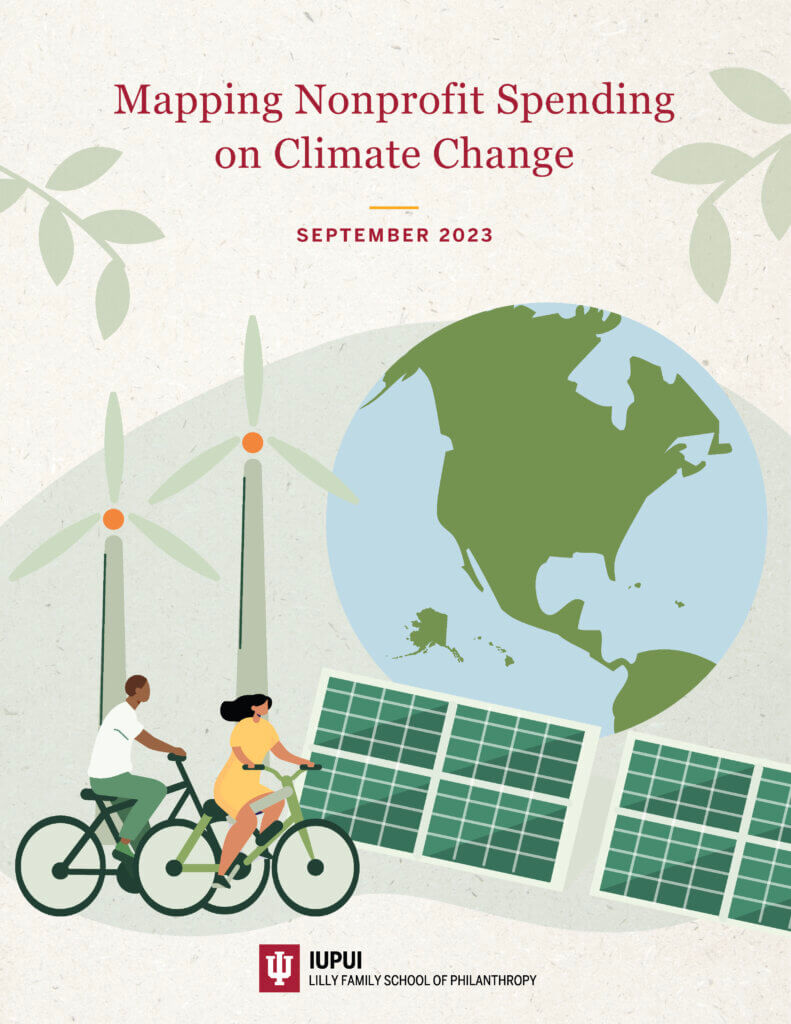A new report provides a fresh perspective on climate philanthropy.
ClimateWorks Foundation’s philanthropic research program has historically focused on insights specific to foundation grantmaking for climate change mitigation. We share this research through publications such as our annual report on funding trends in climate change mitigation philanthropy.

New early-stage research from Indiana University’s Lilly Family School of Philanthropy (the Lilly School) with support from ClimateWorks broadens this scope with bottom-up research examining how U.S.-based nonprofit organizations are allocating their budgets toward climate change.
Learnings from this pilot project confirm some estimates from ClimateWorks’ previous research and raise other new questions to further explore in future research. Here are five things we are taking away from this work:
- Sizing the Sector: The report estimates that nonprofits based in the United States spend between USD $7.8 and $9.2 billion annually on work that addresses climate change, including all funding sources. Approximately 88% ($6.8 to $8 billion) of these total climate expenditures were funded by philanthropic sources, with the remainder from government sources (7%) and fees collected for services (5%). Of this total, roughly half of funds targeted mitigation, 14% targeted adaptation, and the remaining one-third did not fit cleanly into these two categories.
- Regional Spending: Although this survey focused on U.S.-based nonprofits, the respondent organizations focus only a little more than half (54%) of their climate expenditures on strategies focused on the United States and Canada. This is not entirely surprising, as many large global NGOs are headquartered in the United States but work globally or have affiliates elsewhere they may transfer support to. Nonetheless, it is an important reminder that analyses of funding by geography should take into account where the work is ultimately happening, in addition to where grantees are based.
- Tactics and Sectors: Charitable organizations use a variety of tactics across a range of sectors to achieve their goals for climate action. This report reveals that “policy-based approaches” receive the largest share of surveyed organizations’ climate expenditures (30%). Respondents also listed policy-based approaches as one of the biggest funding gaps, indicating the importance of this tactic as a key enabling lever for climate action. Energy comprised the largest focus area of the sample, including both energy use (35%) and energy supply (32%). Land-use-centric approaches follow, accounting for 23% of expenditures.
- What we can learn from a bottom-up view: Much research in the philanthropic sector focuses on the donors — who are they, what are they giving to, and why? The incentives for this are two-fold. First, large donors, whether individuals, foundations, or governments, are more concentrated and easier to study — and in the case of foundations and governments, often legally obligated to disclose their giving. Second, there’s a large constituency of fundraisers and organizations creating a market for this kind of information. This report takes the opposite view — it asks implementing organizations how they are spending funds in service of the climate fight, regardless of where the funds come from and regardless of whether the funds were originally restricted for climate causes or not. This, for the first time, allows us to get a clearer view of the U.S. nonprofit sector’s total spending allocations toward fighting climate change, revealing how organizations have allocated their resources, including to fill holes in causes under-supported by donors, and where we still see persistent funding gaps.
- What we were not able to learn from a bottom-up view: One initial goal of this new research was to better understand how individual donors are supporting climate change and to begin moving to a place where the level of detail available on funding by non-foundation sources approaches the level of detail available from foundations. This level of detail might cover funding not only by sector and region but also dive into sub-sectors. Such analysis may involve for example, questions around how much funding in the ‘transportation’ concentrates on zero-emission vehicles vs. increasing transit mode share vs. developing green fuels. These are three very distinct strategies currently collapsed into one in this data. After an extensive scoping process, it was determined that this level of data will generally not be available in a bottom-up data collection exercise of this type, due to taxonomy and definitional issues as well as the enormous time burden it would put on respondent organizations. We remain optimistic that alternative routes to support data discovery of this kind may emerge as the field develops.
Read the full Lilly School report.

